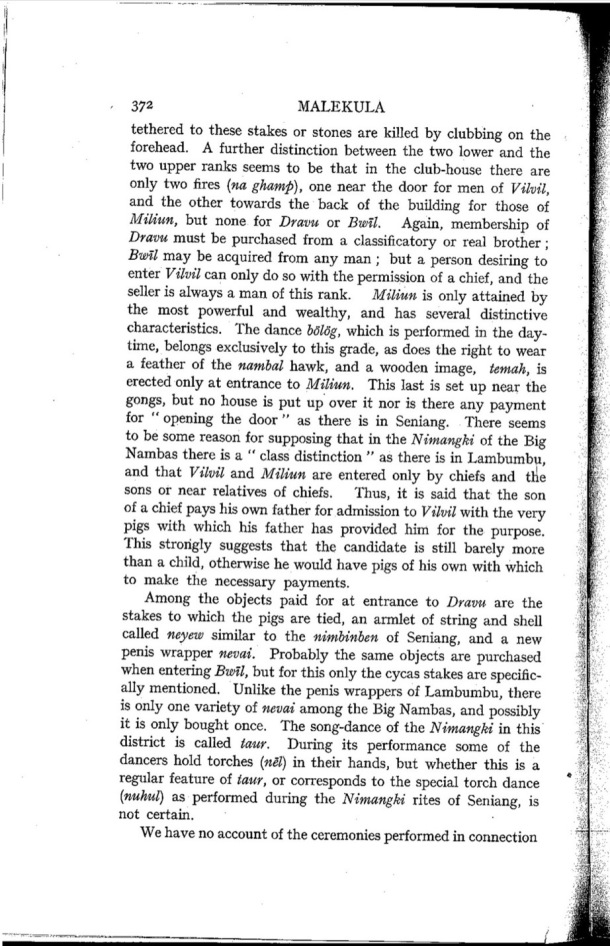|
|  [Note: this transcription was produced by an automatic OCR engine]
372 MALEKULA
tethered to these stakes or stones are killed by clubbing on the
forehead. A further distinction between the two lower and the
two upper ranks seems to be that in the club~housc there are
only two ï¬Åres (na ghamp), one near the door for men of Vilvil,
and the other towards the back of the building for those oi
Mibiun, but none for Dram or Bu/il. Again, membership of
Draw must be purchased from a classiï¬Åcatory or real brother;
Bwil may be acquired from any man ; but a person desiring to
enter Vilvil can only do so with the permission of a chief, and the
seller is always a man of this rank. Miliun is only attained by
the most powerful and wealthy, and has several distinctive
characteristics. The dance bï¬Åldg, which is performed in the day-
time, belongs exclusively to this grade, as does the right to wear
a feather of the Mmbal hawk, and a wooden image, tzmah, is
erected only at entrance to Miliun. This last is set up near the
gangs, but no house is put up. over it nor is there any payment
for “opening the door" as there is in Scniang. There seems
to be some REASON for supposing that in the Nimimgki of the Big
Nambas there is a " class distinction â€ù as there is in Lambumbu,
and that Vilvil and Miliun are entered only by chiefs and tlie
sons or near relatives of chiefs. Thus, it is said that the son
of a chief pays his own father for admission to Viluil with the very
pigs with which his father has provided him for the purpose.
This strongly suggests that the candidate is still barely more
than a child, otherwise he would have pigs of his own with which
to make the necessary payments.
Among the objects paid for at entrance to Draw are the
stakes to which the pigs are tied, an armlet of string and shell
called myew similar to the Mmbinbm of Seniarig, and a new
penis wrapper mvzzi. Probably the same objects are purchased
when entering Bu/il, but for this only the cycas stakes are speciï¬Åc-
ally mentioned. Unlike the penis wrappers of Lambumbu, there
is only one variety of nel/ai among the Big Nambas, and possibly
it is only bought once, The song-dance of the Nimangki in this
district is called lam‘. During its performance some of the
dancers hold torches (nél) in their hands, but whether this is a
regular feature of tuur, or corresponds to the special torch dance
(nuhul) as perfonned during the Nimangki rites of Seniang, is
not certain.
We have no account of the ceremonies performed in connection
1
>
<
r
-, i
or
lake-.‘ 'r~._¢_ :51
§.
1
,2 ‘
.,
_,'
,_ it;
.- ;;i»g.~
I >
|